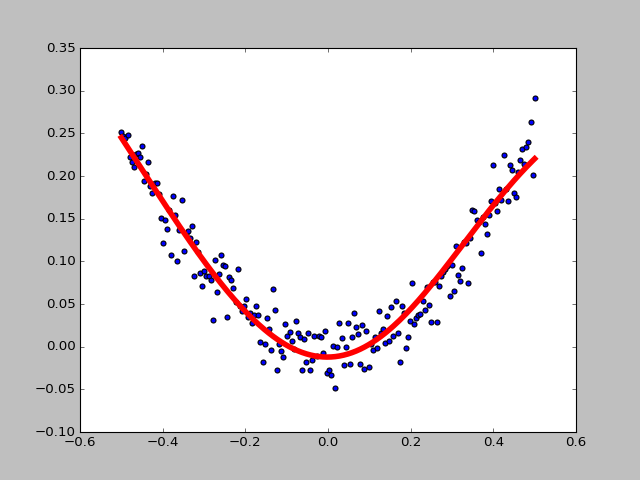#TensorFlow实现线性回归算法
import tensorflow as tf
import numpy as np
import matplotlib.pyplot as plt
#使用numpy生成200个随机点
x_data=np.linspace(-0.5,0.5,200)[:,np.newaxis]
noise=np.random.normal(0,0.02,x_data.shape)
y_data=np.square(x_data)+noise
#定义两个placeholder存放输入数据
x=tf.placeholder(tf.float32,[None,1])
y=tf.placeholder(tf.float32,[None,1])
#定义神经网络中间层
Weights_L1=tf.Variable(tf.random_normal([1,10]))
biases_L1=tf.Variable(tf.zeros([1,10])) #加入偏置项
Wx_plus_b_L1=tf.matmul(x,Weights_L1)+biases_L1
L1=tf.nn.tanh(Wx_plus_b_L1) #加入激活函数
#定义神经网络输出层
Weights_L2=tf.Variable(tf.random_normal([10,1]))
biases_L2=tf.Variable(tf.zeros([1,1])) #加入偏置项
Wx_plus_b_L2=tf.matmul(L1,Weights_L2)+biases_L2
prediction=tf.nn.tanh(Wx_plus_b_L2) #加入激活函数
#定义损失函数(均方差函数)
loss=tf.reduce_mean(tf.square(y-prediction))
#定义反向传播算法(使用梯度下降算法训练)
train_step=tf.train.GradientDescentOptimizer(0.1).minimize(loss)
with tf.Session() as sess:
#变量初始化
sess.run(tf.global_variables_initializer())
#训练2000次
for i in range(2000):
sess.run(train_step,feed_dict={x:x_data,y:y_data})
#获得预测值
prediction_value=sess.run(prediction,feed_dict={x:x_data})
#画图
plt.figure()
plt.scatter(x_data,y_data) #散点是真实值
plt.plot(x_data,prediction_value,'r-',lw=5) #曲线是预测值
plt.show()
结果为:
